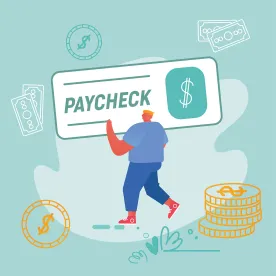Much has been written about the benefits of the PPP loan program. With the second round of funding, roughly $660 billion in PPP loans will be distributed to approved applicants. Approximately 3 million small businesses will receive a PPP loan. The funds provide a desperately needed injection of relief for US businesses struggling to pay their employees over an eight week period during the COVID-19 pandemic.
Well, that is what we want to believe, but our Norman Rockwell view of the PPP loan program is not reality.
Instances of potential abuse of the program have been the recent focus of national media reports, the Secretary of the Treasury, and even the President.
On April 29, the Small Business Administration (SBA) issued guidance in response to this additional scrutiny. The guidance states:
"Specifically, before submitting a PPP application, all borrowers should review carefully the required certification that '[c]urrent economic uncertainty makes this loan request necessary to support the ongoing operations of the Applicant.' Borrowers must make this certification in good faith, taking into account their current business activity and their ability to access other sources of liquidity sufficient to support their ongoing operations in a manner that is not significantly detrimental to the business."
If a borrower did not consider these liquidity criteria when it applied for the loan (because there were no such criteria before April 29), then, according to SBA, the borrower may return the loan proceeds by May 7. Doing so will allow SBA to determine that the borrower applied in good faith, which means that SBA will not subject the borrower to further scrutiny.
As a result, many companies, large, small, publicly traded and privately held, are now rethinking their decision to apply for a PPP loan and asking, "Should I (or must I) return my PPP loan funds?"
What are the risks?
While the decision tree for this question is incredibly complex, if a business decides to retain the funds, what oversight and investigation might they expect in the future? PPP loans are part of the much broader SBA 7(a) loan program. As such, PPP loans have risks that borrowers must keep in mind long after the funds are used, and the forgiveness application is submitted and approved.
SBA employs auditors and analysts tasked with ensuring the terms of 7(a) loans are met. However, SBA has struggled to keep up with auditing 7(a) loans prior to the CARES Act. Today, the SBA faces the daunting challenge of reviewing millions of loans subject to rules and terms that are not exactly the same as for traditional 7(a) loans. We do not know if SBA will turn to the IRS or other Treasury divisions for auditor help.
But we do expect that agency auditors will develop a list of common types of errors and fraud. They will focus on these known areas to flag loan applications and forgiveness applications. Flagged businesses may be subject to additional scrutiny in the form of audits requesting additional documentation and interviews. Those who ignore or otherwise do not comply may receive a visit from law enforcement agents with the Office of Inspector General (OIG). Those agents will come bearing subpoenas authorizing them to seize the business's books, records, and computer equipment. There will be instances of required restitution, fines, and other penalties. In the most egregious of situations, the agency will file claims under the False Claims Act and pursue criminal prosecutions.
This is not the only source of potential risk. Individual "whistleblowers" or attorneys representing "whistleblowers" may file complaints with the agency or qui tam lawsuits under the False Claims Act. While these individual complaints may arise from a genuine concern and interest in preventing abuses of this massive loan program, other facts may motivate a whistleblower including personal greed (whistleblowers may receive a percentage of what the government recovers in a False Claims Act investigation) or a vendetta against the company.
How to address those risks
There are, broadly speaking, four steps to the PPP loan process: Application, Approval, Utilization, and Forgiveness.
Here are some practical tips at each stage of the process to help businesses with PPP loans plan and prepare for potential agency scrutiny.
Application
Every applicant should have a thorough understanding of the information sought by the application. It is unlikely an investigator will let you slide with an excuse of "I did not understand the question." If you do not understand a question or you are unsure of your response to a question, seek out someone who does. That could be your attorney, accountant, lender, or a business mentor.
Make notes of these conversations. Include who you talked with and when. If you receive emails or other written advice, keep that with the other records used in preparing the application. Records and communications between you and counsel generally are privileged and should be kept in a separate subfolder marked "privileged."
You should maintain and retain all documentation supporting your answers to the PPP loan eligibility criteria and certifications.
As to the certification that "current economic conditions make this loan request necessary to support ongoing operations of the Applicant," consider a written position statement identifying all of the reasons (cite to source documents) why your business needs this PPP loan. In the position statement, you may indicate that you consulted with counsel, but avoid any direct references to what legal counsel told you, so as to protect the privileged nature of those communications.
Finally, maintain a separate file with a copy of your application, all of your business records you reviewed in preparing the application, and any other documentation you relied on to complete the application process. All payroll, other compensation records, and employee data certainly should be a part of this file. Keep the PPP loan application file in a secure and safe location. If you are storing that information electronically, maintain a back-up, and limit access to these electronic files.
Approval
Just as you have done with the application process, maintain a file with your approval documentation. Be sure to include copies of all emails or other correspondences with your lender. Document the receipt of funds and where those funds were deposited. It is strongly recommended that you maintain a separate account for your PPP loan funds.
Utilization
This is a critical stage. The documentation you maintain and retain during this step forms the basis for your forgiveness application. You should segregate and maintain business records on a contemporaneous basis. Eight weeks will pass very quickly. If you wait until week seven to begin looking for the records to support your forgiveness request, at the very least, you will be stressed. At worst, your failure to maintain and retain records will result in your lender denying some or all of your forgiveness request.
Your utilization file should include: All payroll and non-payroll expenses, employee records to verify FTE calculations, both for the two "baseline" FTE periods as well as your FTE calculations for the eight weeks covered period, and related source documentation (i.e., bank account statements, cancelled checks, utility bills, a copy of your lease, etc.).
Additionally, you may want to consider purchasing a forgiveness report, like the one we developed, that produces detailed recommendations customized to your circumstances. This information can help guide your loan utilization. Our report was designed to help our clients maximize the amount of their loan that will be eligible for forgiveness.
Forgiveness
What the forgiveness application will look like remains unknown, but likely it will vary from lender to lender. Your forgiveness file will include a copy of the application, all supporting documentation, and your lenders' forgiveness determination. In other words, this file will have copies of items from both the application and utilization files. Maintain a copy of all communications with your lender related to the forgiveness process.
If you have not done so already, consider securing guidance from legal counsel regarding both your eligibility for the program, the uses of your PPP loan, and the amount of forgiveness you should expect to receive.
Post-Forgiveness and Payment
It will come as no surprise to most business owners that an audit or investigation request may come months or years after your PPP loan is forgiven, paid, or both. With loans that close, the SBA instructs lenders to retain key records for up to ten years from payment or other disposition. Borrowers should also follow this general guideline.
Conclusion
If your business applied for, secured, and retained PPP loan funding, your work has just begun. Following the guidance above should assist with the forgiveness process, and better prepare you for interactions with the SBA or OIG long after your PPP loan is forgiven or paid.





 />i
/>i

